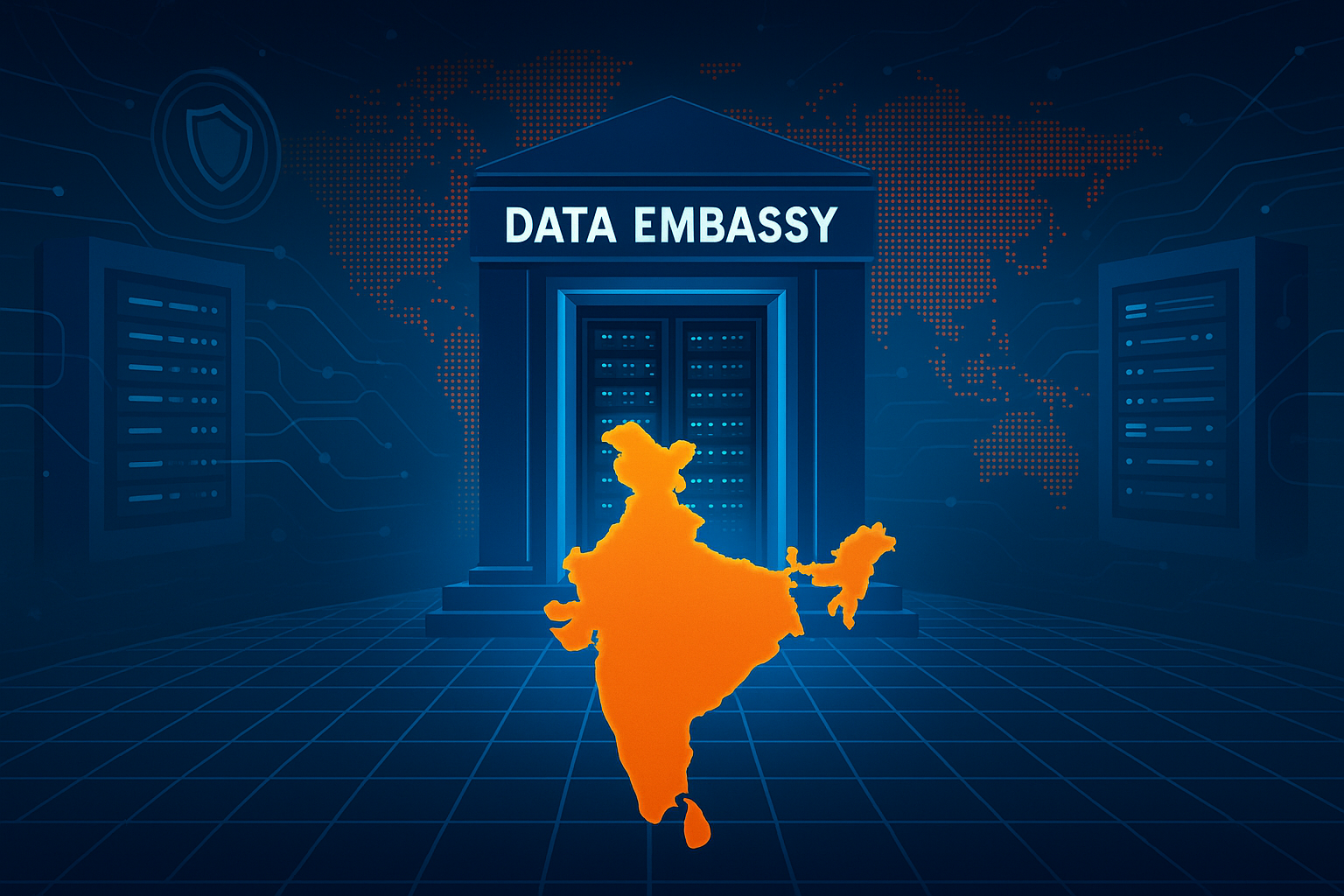The escalating geopolitical tensions and unprecedented rise in global conflicts have fundamentally transformed the landscape of digital security and data sovereignty . As nations grapple with protecting their critical digital infrastructure from cyber warfare and state-sponsored attacks, the concept of data embassies has emerged as a revolutionary approach to ensuring digital continuity and national security. This comprehensive analysis examines the strategic, economic, and technical dimensions of data embassy implementation, with particular focus on India’s potential to become a global hub for secure cross-border data storage.
Understanding Data Embassies: Concept and Origins
A data embassy represents a paradigm shift in digital governance, functioning as a secure data center located in a foreign country that stores critical government data and information systems under diplomatic protection. This innovative concept extends the traditional Vienna Convention principles of diplomatic immunity to digital infrastructure, creating sovereign digital territories beyond national borders
Estonia launched the first operational data embassy in Luxembourg in 2017, following crippling cyberattacks in 2007. It now houses over 10 national databases, including e-land registry and population registries, secured under Tier IV protocols
Data Embassies are not just backups. They are resilient governance tools, disaster recovery platforms, and diplomatic statements about who owns data, and where it lives in a borderless digital world.
Global Drivers of Demand
The accelerating global demand for data embassies is rooted in the convergence of geopolitical instability, cyber threats, and growing anxieties over digital sovereignty. Governments across the world are awakening to the reality that physical borders are no longer sufficient to safeguard national continuity in the face of hostile cyber activity. This new security calculus has led to the emergence of data embassies as a strategic response to mounting risks.
One of the most consequential turning points was Russia’s invasion of Ukraine in 2022, which dramatically exposed the vulnerabilities of centralized digital infrastructure in active conflict zones. Ukrainian government institutions faced coordinated cyberattacks aimed at disabling state systems, erasing data, and spreading misinformation. These attacks, believed to be state-sponsored, targeted not only military assets but also healthcare systems, communications networks, and public registries. In response, several nations began to proactively explore offshore digital sanctuaries to ensure business continuity and governmental operations even if national servers were compromised or physically destroyed.
Simultaneously, concerns over China’s surveillance-linked cloud infrastructure have created unease among many developing nations. As China exports cloud and telecom infrastructure through projects tied to its Digital Silk Road and Belt and Road Initiative (BRI), fears have grown over vendor lock-in, hidden backdoors, and the erosion of digital autonomy. Governments in Africa, Southeast Asia, and Latin America—many of whom rely heavily on Chinese-built cloud systems—have become increasingly wary of how and where their data is being stored, who has access to it, and whether their digital sovereignty is being compromised in the process. This has sparked a growing demand for neutral, trusted, and geopolitically non-aligned partners to host critical digital assets.
In parallel, the rise of sophisticated ransomware attacks has served as another powerful wake-up call for states. Countries like Costa Rica and Australia have experienced large-scale cyberattacks that paralyzed essential public services—from customs and tax platforms to hospital IT systems. In 2022, Costa Rica declared a state of emergency following a crippling ransomware breach that targeted nearly 30 government institutions. In Australia, a series of high-profile breaches compromised health data, telecom services, and public infrastructure. These incidents underscored the risks of centralized digital hosting and reinforced the need for resilient, distributed, and sovereign-grade storage solutions such as data embassies .
Recognizing the criticality of this issue, the World Economic Forum now categorizes data infrastructure as critical national infrastructure—placing it on par with oil pipelines, energy grids, and telecommunication networks. This reflects a broader shift in global thinking: that data is no longer merely a commodity or IT asset, but a core national interest that must be protected through layered, resilient, and geopolitically aware strategies.
Read more about Data Security Council of India
Several nations have already taken steps to implement or explore data embassy frameworks. These include:
- The Estonia–Luxembourg Treaty (2017): This pioneering agreement allowed Estonia to store key national databases—such as identity records and land registries—on foreign soil while maintaining full legal jurisdiction. It marked the first legally recognized digital extension of national sovereignty.
- Iceland’s International Data Sanctuaries: With its renewable energy, low temperatures, and political neutrality, Iceland has positioned itself as a natural host for international data refuges, particularly for organizations concerned about environmental sustainability and resilience.
- Singapore’s Digital Government Exchange Zones: Singapore has established regulated zones for cloud services and digital infrastructure, backed by rigorous compliance regimes, that allow it to serve as a regional digital hub with sovereign assurance.
- France’s “Cloud de Confiance” (Trusted Cloud): France launched this initiative to encourage the use of sovereign and secure cloud services by public institutions and critical businesses, further emphasizing national control over strategic data.
Despite these advancements, demand for sovereign-grade data hosting continues to vastly exceed global supply, particularly in Africa, Latin America, and Southeast Asia. These regions often lack the domestic infrastructure, legal capacity, or geopolitical neutrality needed to build sovereign data environments on their own. As a result, they are increasingly searching for trusted partners who can offer both the infrastructure and the legal guarantees required for secure data hosting .
This presents an India-sized opportunity.
Economic Framework and Infrastructure Costs
The economics of data embassy establishment involve substantial initial capital expenditure coupled with ongoing operational costs that vary significantly by geographic location. Global data center construction costs typically range from $7-12 million per megawatt of IT capacity, with variations based on regional factors including labor costs, land availability, and infrastructure maturity.
Data Center Construction Costs by Region (Per MW)
India emerges as a highly competitive destination for data embassy infrastructure, with construction costs estimated at $5.4 million per megawatt—representing a 43% cost advantage over the global average. This cost structure breaks down into several key components: electrical systems accounting for 40-45% of total costs, land acquisition representing 15-20%, HVAC and cooling systems comprising 15-20%, and building fit-out constituting 20-25%
The operational expenditure for modern data centers ranges from $10-25 million annually, influenced by power consumption, maintenance requirements, and staffing costs. India’s operational advantages include lower power costs, abundant skilled technical workforce, and established IT services ecosystem that reduces long-term operational expenses
Model Summaries
A Data Embassy can be hosted through various deployment models, each suited to the data sensitivity, diplomatic arrangement, and infrastructure maturity of the host and guest nations. 🏗️ Hosting Models
| Model | Description | Example |
| Physical Embassy | Treaty-backed data center with full sovereign protection | Estonia–Luxembourg |
| Sovereign Cloud | Cloud infra with geo-fencing and data sovereignty controls | Microsoft Azure Government Cloud |
| Hybrid Model | Partially hosted abroad, partially retained domestically | UAE–AWS/Oracle collaboration |
| Co-location Treaty | Existing DC leased with legal protections for foreign government use | India-Africa proposal (hypothetical) |
- Physical Embassy Data Center (DC)
- Description: A dedicated, physically isolated facility in the host country, protected by a bilateral treaty that grants it diplomatic status.
- Example: Estonia’s data embassy in Luxembourg, which stores critical national registries under diplomatic immunity.
- Best for: Nations with the highest sensitivity data and strong diplomatic ties.
- Sovereign Cloud
- Description: Utilizes public cloud infrastructure with strict sovereign controls, geo-fencing, and compliance with the guest nation’s legal requirements.
- Example: Microsoft Azure Government Cloud, which offers sovereign cloud services to governments.
- Best for: Countries seeking scalability and cost efficiency without full physical control.
- Hybrid Embassy Model
- Description: Data is split between the host nation’s infrastructure and secure backups in the home country, balancing resilience and sovereignty.
- Example: UAE’s partnerships with AWS and Oracle, combining local and international storage.
- Best for: States wanting redundancy and flexibility.
- Co-location Treaty
- Description: Leasing space in an existing data center, but with diplomatic rights and legal protections for the data.
- Example: Hypothetical India-Africa model, where African nations lease space in Indian data centers under special treaties.
- Best for: Nations with budget constraints or those piloting data embassy concepts.
Technical Stack Essentials
A robust Data Embassy requires a multi-layered technical foundation:
- Infrastructure Layer: Tier IV data centers, redundant power, advanced DDoS protection.
- Network Layer: Redundant fiber connectivity, ensuring <50ms latency to the guest country for real-time access.
- Security Layer: End-to-end encryption (in transit and at rest), tokenization, and air-gapped systems for the most sensitive data.
- Access Layer: Multi-factor authentication, secure tunnels (VPN, SD-WAN) for authorized personnel.
- Governance Layer: Real-time monitoring, comprehensive audit trails, and zero-trust security architecture.
Regulatory Framework and Legislative Requirements
India’s regulatory landscape for data governance has undergone substantial transformation in recent years, driven by the twin imperatives of protecting individual privacy and asserting national data sovereignty. The most significant milestone in this journey has been the enactment of the Digital Personal Data Protection (DPDP) Act, 2023, which lays the foundation for a comprehensive framework governing data collection, storage, and transfer — both within and beyond India’s borders. This legislation marks India’s first consolidated privacy law, aligning the country more closely with global data protection regimes such as the European Union’s General Data Protection Regulation (GDPR).
Crucially, the DPDP Act provides the legal basis for cross-border data transfers, permitting them to specified “trusted geographies.” However, the criteria for determining these geographies remain undefined, leaving critical gaps that could complicate India’s efforts to host foreign data embassies. Without clear benchmarks for bilateral data trustworthiness, foreign governments may hesitate to enter into sovereign data hosting agreements.
The current regulatory ecosystem includes three major instruments:
- Information Technology (IT) Act, 2000 – India’s first cyber law, currently outdated and set to be replaced by the Digital India Act.
- Digital Personal Data Protection (DPDP) Act, 2023 – Defines personal data handling, cross-border transfer conditions, and purpose limitations .
- National Data Governance Framework Policy – A draft policy that seeks to regulate non-personal data access, data anonymization, and standardization of data-sharing practices across sectors.
Together, these policies govern key elements critical to Data Embassy operations — including data localization, sovereign data protections, cybersecurity obligations, and cloud infrastructure regulation. However, India still lacks legislation that explicitly recognizes or supports sovereign digital zones or data embassies under international law.
An instructive example lies in Bahrain’s Legislative Decree No. 56 of 2018, which provides a legal pathway for foreign entities to store data in Bahraini data centers while maintaining jurisdiction under their own domestic laws . This model successfully balances host-country sovereignty with guest-country legal control, and serves as a viable legislative blueprint for India to emulate
India’s Strategic Advantage
India is uniquely positioned to become the default data host for the Global South and neutral nations due to:
- Booming Cloud Ecosystem: Rapid growth in cloud infrastructure and services.
- Mature IT Services Base: World-class IT firms (Infosys, TCS, Zoho, HCL) capable of building and managing sovereign cloud backbones.
- Affordable Renewable Energy: Lower operational costs and sustainability for large-scale data centers.
- Geopolitical Stability: Relative insulation from major global conflicts and natural disasters.
Infrastructure & Technology Roadmap
- National Data Embassy Cluster Initiative: Identify 3–4 high-connectivity, low-latency regions (e.g., Chennai, Vizag, Gujarat, Hyderabad) for sovereign-grade hosting.
- Public-Private Partnerships: Collaborate with Indian IT majors to develop and operate sovereign cloud infrastructure.
- Cyber Readiness Index: Launch an India-specific digital risk index to provide transparency and confidence for foreign partners .
Economic & Diplomatic Levers
- Data Hosting Subsidies for LDCs: Offer subsidized hosting to Least Developed Countries as a form of digital foreign aid, enhancing India’s soft power.
- “Digital Maitri” Initiative: Launch a flagship diplomatic program, modeled after India’s successful Vaccine Diplomacy, to position India as a trusted global data custodian.
Gaps and Challenges in India’s Legal and Technical Readiness
While India possesses considerable infrastructure and legal momentum, several critical bottlenecks must be addressed to unlock its potential as a data embassy host:
Legal and Regulatory Gaps
- No Specific Legal Status for Data Embassies
India does not yet recognize digital embassies or sovereign data zones under any domestic statute or international treaty, unlike Estonia and Bahrain. The absence of legal language around jurisdiction, immunity, or data ownership deters treaty-grade hosting arrangements. - Undefined Cross-Border Transfer Criteria
Although the DPDP Act permits international data transfers, the government has not released guidelines to determine “trusted countries.” This legal ambiguity undermines bilateral trust and limits India’s ability to offer sovereign-grade guarantees. - Lack of Diplomatic Immunity for Digital Assets
While physical embassies are protected under the Vienna Convention, no equivalent framework exists for digital embassies. India currently lacks legal provisions to grant digital content hosted in India the same immunity that physical embassies enjoy.
Technical Shortcomings
- Fragmented Hosting Ecosystem
India’s data hosting market is booming, but there is no centralized registry or single-window sovereign hosting mechanism. Foreign governments navigating multiple jurisdictions and compliance regimes face a fragmented and often opaque regulatory environment. - Outdated Cybersecurity Policy
India’s national cybersecurity policy, last updated in 2013, lacks a forward-looking framework for zero-trust architecture, incident response norms, and cloud sovereignty. Moreover, CERT-In’s guidelines remain reactive, failing to provide preemptive assurance to prospective data embassy partners. - Shortage of Treaty-Grade Skilled Workforce
Operating a sovereign data facility demands specialized skills in cryptographic key management, compliance law, and international incident response. India’s current workforce is strong in general IT services but lacks dedicated talent pools for sovereign hosting and treaty enforcement.
Recommended Legal and Diplomatic Reforms
To position India as a global leader in sovereign data hosting, a set of focused regulatory interventions and foreign policy shifts is essential:
Introduce “Digital Embassy Zones”
Through either amendments to the DPDP Act or fresh legislation, India should create legally defined Digital Embassy Zones — special infrastructure corridors or data centers designated for foreign sovereign data hosting.
These zones must guarantee:
- Bilateral data immunity, ensuring exclusive legal jurisdiction for the guest nation.
- International arbitration provisions, for resolving disputes.
- Certification and audit mechanisms, to maintain compliance and trust.
Embed Data Diplomacy in Foreign Policy
The Ministry of External Affairs (MEA) must incorporate sovereign data hosting into India’s broader diplomatic strategy. Bilateral and multilateral data agreements should be positioned alongside trade, defense, and development partnerships — particularly with Global South nations in need of secure, cost-effective digital infrastructure.
Fast-Track GDPR Equivalency
To build trust with European and North American nations, India should expedite the process of achieving GDPR adequacy, which would allow seamless data transfer between jurisdictions and reduce compliance friction for prospective data embassy clients.
Implementation Roadmap and Timeline
India’s path to becoming a global data embassy hub follows a strategic timeline spanning 2023 to 2030, with critical regulatory and infrastructure milestones. The Digital Personal Data Protection Act passage in 2023 established the legal foundation, while 2024 focuses on National Data Governance Framework implementation.
The projected timeline anticipates the Digital India Act implementation in 2025, followed by first bilateral data embassy agreements in 2026 and operational India Data Embassy Hub by 2027. Multiple international partnerships are expected by 2028, culminating in establishment of a regional data sovereignty center by 2030.
Supreme Court Tells Cops to Learn Free Speech—But Does It Follow Its Own Advice?




